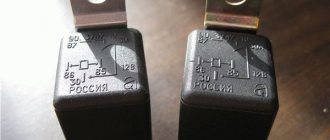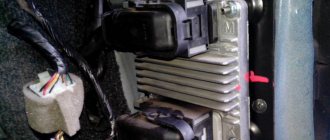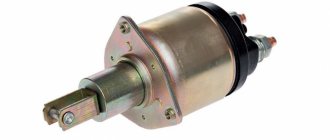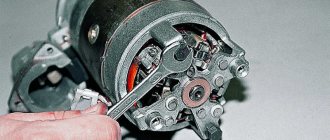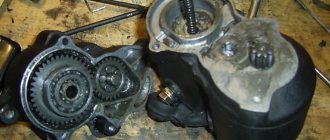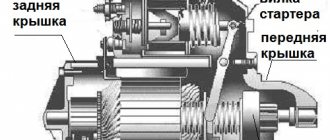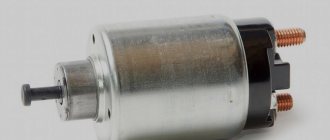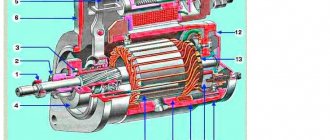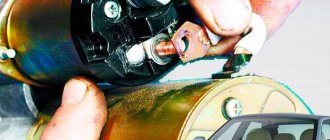The starter in a car is designed to start the engine. A short-term charge is supplied from the ABC to the starter, which in turn rotates the flywheel at high speed. The Daewoo Nexia starter is reliable, although it has its own resource, so it also requires maintenance and repair. In the article we will talk about the causes of the malfunction, selection of a starter and replacement and repair procedures, as well as the manufacturer’s recommendations.
Video
The video will tell you how to replace the starter on Nexia
Prices for Daewoo Nexia starter repair
One hundred percent operational efficiency and the availability of a wide range of spare parts allows us to maintain affordable prices for all types of services, including replacement of the Bendix starter and complete replacement of the Daewoo Nexia starter.
| Service name | Price |
| Starter replacement | from 1500 rub. |
| Starter repair | from 2500 rub. |
The cost of the work must be agreed upon with the specialist by phone!
Where did the spark go for Nexia?
WHERE THE SPARK WENT AT NEXIA
WHERE THE SPARK WENT AT NEXIA How the insidious defect was diagnosed and ultimately overcome, says the head of the company’s technical center in Kazan.
The problem of “starting or not starting” has probably existed since the invention of the automobile.
With the advent of reliable and relatively inexpensive Nexias from Uzbekistan, the owners of Zhiguli and Samara cars who moved to them finally felt like people, but at the same time they realized that their Zhiguli experience was of little use for a new car. And if something happens, there is only one way - to a car service center.
The first time we encountered an Uzbek Nexia, which sometimes refused to start, was in the fall of 1997. According to the owner (I mean “words”, since I had a chance to see with my own eyes a car whose engine would not start much later), the car put him in an awkward position a couple of times, but after a few minutes (obviously, while the owner was wiping the headlights, windows and kicking wheels) started up as if nothing had happened. That case turned out to be not an isolated one. In cars suffering from a similar illness, the engine could refuse to start at any moment - after a long or short stay, in bad or good weather, in a garage or in the fresh air. Just as unexpectedly, he could quit fooling around and work normally for a week, a month, and then it all started again. It happened that the Nexia was towed to us, the master got behind the wheel, and... the engine started, as they say, with half a kick! This problem drove the owners to white heat; they began to be afraid of their cars.
In short, we were dealing with a typical “floating” defect - one of those that can make a car service specialist doubt the correctness of his choice of profession. Extensive (by that time three years) experience in working with Daewoo cars from Korea could not help - they never encountered such a defect, they always started.
Repairing such cars (how can you repair a working car?) had to be guided by the principle that “electronics is the science of contacts,” that is, by disconnecting and connecting electrical connectors, cleaning, blowing. Sometimes it helped, more often it didn’t. But statistics, the greatest of sciences, did its job - the overall picture began to emerge. The engine of the defective cars did not start due to the lack of a spark on the ignition coil, and “plus” was supplied to it, that is, pulses were not formed in the primary winding. If you try to start the engine “from the pusher” at this moment, it starts instantly. These two factors were a necessary and sufficient condition for the subsequent recommendations to be applied. But first, a little theory.
A schematic diagram of the Nexia ignition system is shown in the figure. The distributor housing contains a magnetoelectric pulse sensor (not to be confused with a Hall sensor) and an electronic module (switch, if you like). The pulse sensor consists of a magnetized rotor, integral with the distributor shaft, and a stator, which includes two pairs of poles and an induction coil in which an electromotive force (EMF) is induced with a frequency in the starter mode of 8 Hz and an amplitude of about 2 V. The electronic module converts these pulses are rectangular with an amplitude of 12 V and supplies them to the primary winding of the ignition coil. After starting the engine, the ignition system also switches on the electronic control unit (ECU), which controls the change in the ignition timing depending on the engine operating modes.
It was most logical to assume that the cause of all the troubles was in the module. After all, the word “switchboard”, pronounced with the appropriate epithets in the company of motorists, immediately gives rise to sympathetic nods of heads and a sea of sad memories. However, replacing switches on problem cars with a promise to return the money if the defect does not disappear, led to the return of money and counter questions: well, what next? But really - what if the electronic module, the ignition coil, and the ECU are checked and working normally, what remains? Is it really a sensor? No, I don’t even want to think about it, because it is primitive to the extreme. The only part in it that can fail is the induction coil, and even that is a plastic coil with a copper wire with a diameter of 0.1 mm wound around it. To check the performance of the coil, the Nexia car repair instructions require measuring its resistance, and if it is in the range of 500–1500 Ohms, then everything is in order. We measured this resistance in dozens of coils, and it was always in the range of 750–800 Ohms.
The main symptoms of a malfunction of the ignition switch contact group
The main signs by which you can understand that the contact group is burnt out and does not work or will soon break. You can touch it, the contact group gets very hot, turning on the low beam, heater, windshield wipers, radio - at this moment there is a colossal load on the contact group, the contacts get very hot and the plastic begins to melt. The contact group will work for some time, but due to the fact that the plastic has melted, the contact has become even worse - a breakdown is not far off.
So the first sign is strong heating of the contact group. The second and main sign is the smell of burnt wires or plastic. If you remove the steering column casing, you will smell a burning smell and see a picture - blackened, burnt wires and a corrected contact group. Consider this article your salvation, you just need to read it to the end.
There is also a situation when you turn the key, but the car does not react. Nexia has a standard problem. This means 99 percent that your contact group has received a hitch. But don’t despair, if you don’t have a contact group at hand, you can drive normally by starting the engine with wires (see How to start a Nexia engine with wires without keys). If when you turn the key, the car does not start, then the contact group is to blame. It also happens that the starter simply does not turn when you turn the key - this is the same trouble.
Daewoo Nexia starter repair in Moscow auto repair shops
35 car repair companies
- TTS Motors
- Pyatnitskoe highway, 2
- +7 (495) 24… show all
- The site of the company
- Lorant
- Wilgood
- Garimotors
- Lexus on the market
- Auto-rad
- Wilgood
- Wilgood
- Wilgood
- Wilgood
- Wilgood
- Wilgood
Popular companies
Starter for Daewoo Nexia
Analogue produced by .
The basic design of the starter has remained virtually unchanged throughout the production of the car - it is a 4-pole electric motor with 4 DC brushes, combined with a solenoid electromagnetic relay.
8 valves
On 8-valve engines of early years of production, starters were installed without a planetary gearbox, and therefore less power . In good weather conditions, the difference in performance between the two starters was practically not felt, but as soon as frost hit, the old starters for eight-valve engines could barely cope with their work. Their power (for example, Delta autotechnik A17120 ) ranged from 0.7 to 0.9 kW .
16 valves
Starters for 16-valve 1.6-liter engines began to be equipped with a planetary gearbox and, accordingly, the electric motor power increased to 1.3 kW.
This affected both the torque of the electric motor and its ability to start a larger engine even in cold weather. For example, EAI 11510 already produced 1.4 kW. Also on sale you can find 1.2 kW units with a planetary gearbox from Achim with catalog number 96469963 made in Korea.
Their price is about 4 thousand rubles.
What is the difference?
On the left is an old starter without a gearbox, on the right is a new starter with a planetary gearbox.
Visually, they differ from starters for a 1.5-liter eight-valve engine by the presence of studs for mounting the planetary gearbox . Otherwise, the process of dismantling the old and new starters is no different, as we will now see.
Fuse diagram
The base of the block is no different for cars produced in 2000 and 2011. Also, the eight-valve version and the sixteen-valve engines are protected by the same fuses.
The standard electrical circuit is deciphered as follows:
- F1 – ECU system, protects the power cores of the device;
- F2 – system of dimensions;
- F3 – not used;
- F4 – head optics high beam mode fuse;
- F5/6 – low beam, correction of the right and left headlights, respectively;
- F7 – fuel system;
- F8 – turns in operating mode, emergency lights and stops;
- F9 – wipers;
- F10 – protective element of the electric lock of the windshield lid;
- F11 – air conditioning compressor;
- F12 – low rotation speed of the stove fan;
- F13 – fuse F13 is multifunctional, the element is responsible for the cigarette lighter, instrument panel, and works as an auxiliary element of the generator circuit;
- F14 – horn and heater fan;
- F15 – interior lighting of the interior, glove compartment and cargo compartment;
- F16 – power supply for electric door windows;
- F17 – comes into operation when the tape recorder is powered from the ignition switch;
- F18 – central locking, radio power supply from battery, luggage compartment lid lock drive.
There are also several relays here.
- Maximum operating mode of the stove fan.
- Turn signals in blinking mode.
- Fuel pump switch relay.
- Front and rear fog lights.
When installing powerful optics, the foglight switch often burns out or fails to cope. To unload the element, users install an auxiliary unit and energize the rear lights to it.
The additional part contains a small number of fuse links:
- F20 – climate control;
- F21 – standard fog lights.
Drivers deal with a constantly burning element in the same way as with a relay. A separate line is drawn and powered through a common switch.
We remove the starter for the Daewoo Nexia with our own hands
Depending on the type of engine and year of manufacture, different elements of electrical equipment were installed on the Daewoo Nexia. Today we will understand the intricacies of the starter of different years of production and its dismantling. The differences are quite significant, although the starters look almost the same. Nevertheless, when replacing or repairing a unit, these little things must be taken into account.
How to check the device for serviceability?
The distributor diagnostic procedure is carried out as follows:
- First, you need to look at the engine in the dark to see if there are sparks in the distributor area. If there is, then this indicates a violation of the insulation. Remember to always keep the lid dry.
- Also diagnose the integrity of the wiring - whether the contacts are intact or not. The terminals themselves on the cover must not be removed.
- Remove the cover and diagnose the integrity of the slider. After removal, look at the inside of the cover to see if the contacts are intact.
- Try shaking the slider - any gaps are eliminated. If there is play, there will be an unstable gap in the contacts.
- Diagnose the wear and gap in the contacts - it should be no more than 2 mm, the less the gap, the better. If the contacts are burnt, they must be cleaned.
- Then connect the lamp to the side terminal of the distributor and turn on the ignition. Try turning the engine manually - at this time the lamp should blink and go out at regular intervals. If this does not happen, then most likely there is a short circuit in the system, as a rule, this is due to the fact that the moving part touches the housing itself (the author of the video about diagnosing the distributor cap at home is Auto Electrics HF).
Is it possible to repair the solenoid relay?
On older modifications of starters, this was possible. After clicks appear, simply remove the relay and disassemble it. There is a contact pad inside, usually a plate and two contacts. Oxides can form between them, as well as plastic film from a long start-up. We need to clean this part and performance will be restored.
Watch this helpful video.
HOWEVER. New modifications of the relay are NOT SEPARABLE. They cannot be easily disassembled (without destroying the case) and cleaned. Often a replacement is needed. YES, they break down once every 120 - 150,000 km (and maybe less often) and replacing them is not that expensive.
Causes of starter malfunctions
Before you begin the repair or replacement process, you need to know the reasons for the unit malfunction. They are quite familiar to many car enthusiasts. There are quite a few reasons for the Daewoo Nexia starter not working, but let’s look at the main ones:
- The battery does not work;
- terminal oxidation;
- traction relay closing;
- open circuit of the traction relay;
- inoperability of contact ignition;
- anchor jams;
- wear and sticking of brushes;
- ignition circuit break;
- clutch is faulty;
- drive gear wear;
- the gear does not fit on the flywheel teeth;
- armature bearing wear.
These are some of the reasons for the impossibility of starting the starter, and therefore the engine.
Car starter design
Every car owner should know the design of the mechanisms and components of his vehicle. If you understand the operation of the mechanism, you can easily and quickly identify the breakdown and fix it.
Main components of the unit:
- electric motor,
- anchor,
- brushes,
- overrunning clutch.
Some car models may have differences in structure. This should not be taken as a deviation; this happens often. If you are purchasing a part, you must inform the seller about the model of the part that was previously used. If you select the element incorrectly, difficulties may arise with its operation, and it will quickly fail.
If the starter does not respond to the rotation of the key and is in silent mode, then the check is divided into the following stages:
- The battery charge level is detected.
- The ignition switch contacts are being checked.
- The traction relay is being diagnosed.
- The operation of the part of the starter responsible for torsion of the clutch and the mechanism itself are checked.
Replacement instructions
Let's consider the process of replacing the distributor using the Daewoo Matiz model as an example:
- Disconnect the battery and unscrew the bolts of the air intake, as well as the air filter element. Dismantle it.
- Next, disconnect the hose that connects the throttle to the filter and dismantle it.
- Disconnect the high-voltage cables from the device cover, but before doing so, mark their position.
- Remove the block with wires from the breaker.
- Using a 12mm socket wrench and a small ratchet with an extension, remove the screws of the breaker device. Place a rag under it, as some of the engine fluid may come out when dismantling the device. Twist the assembly a little and remove it. When removing, pay attention to the limit switch - its antennae are installed with a slight offset, and not in the center, so when installing a new device, install the limit switch in the same way.
- Install the new distribution unit, tighten the lower fixing screw, but not completely. Do the same with the top bolt.
- Reconnect the high-voltage cables, observing the order in which they are connected. Further assembly steps are carried out in reverse order. After installing the unit, it is necessary to adjust the idle speed and ignition. If the ignition is set incorrectly, the symptoms will be the same as if the distributor breaks down.
Photo gallery “Replacing the device yourself”
Car starter design
Every car owner should know the design of the mechanisms and components of his vehicle. If you understand the operation of the mechanism, you can easily and quickly identify the breakdown and fix it.
Main components of the unit:
- electric motor,
- anchor,
- brushes,
- overrunning clutch.
Some car models may have differences in structure. This should not be taken as a deviation; this happens often. If you are purchasing a part, you must inform the seller about the model of the part that was previously used. If you select the element incorrectly, difficulties may arise with its operation, and it will quickly fail.
If the starter does not respond to the rotation of the key and is in silent mode, then the check is divided into the following stages:
- The battery charge level is detected.
- The ignition switch contacts are being checked.
- The traction relay is being diagnosed.
- The operation of the part of the starter responsible for torsion of the clutch and the mechanism itself are checked.
Required Tools
To replace the starter on a Nexia, you need a list of tools, which is presented in the table below.
Table - Tools required to replace the front strut
| Name | Note |
| Head | “at 10”, “at 13” |
| Extension | Preferably with a ratchet |
| Short open-end wrench | “at 10”, “at 13” |
| Screwdriver | With cross and flat blade |
| Socket wrench | “at 7”, “at 8”, “at 10”, “at 13”, “at 15” |
| Rags | To clean dirt |
To remove and install the starter, access is required from the bottom of the vehicle. Therefore, when carrying out operations, it is important to have an inspection hole, overpass or lift.
Replacing the Daewoo Nexia starter
The starter in a car is designed to start the engine. A short-term charge is supplied from the ABC to the starter, which in turn rotates the flywheel at high speed. The Daewoo Nexia starter is reliable, although it has its own resource, so it also requires maintenance and repair. In the article we will talk about the causes of the malfunction, selection of a starter and replacement and repair procedures, as well as the manufacturer’s recommendations.
Video
The video will tell you how to replace the starter on Nexia
relays and fuses
The contact group is the cause of starter failure. But perhaps the most common cause of starter failure is the failure of the contact group. If the starter works by itself, as the first test showed, then with a high degree of probability the fault can be caused by the contact group of the ignition switch.
The starter drives on the Daewoo NEXIA, what's the problem?
The fact is that when designing the electrical circuit, the engineers did not take into account the high load on the ignition switch contacts. When starting the engine, voltage from the battery is supplied directly to the contact group and when the starter is turned on, a large current passes through the contacts, they heat up and burn out over time.
Paid links
How to prevent the contact group from breaking down Of course, you can simply replace the contact group on Nexia, but there is no guarantee that the story of contact burnout will not repeat itself.
To avoid problems occurring in the future, it is necessary to unload contacts 15 and 30 of the contact group.
To do this, it is necessary to install an unloading relay between these contacts. A regular starter relay from a VAZ will do, connected according to the diagram between pins 15 and Let's understand the connection diagram: Connect the wires to the terminal block. We get to the ignition switch by removing the steering column covers.
What was used in the renovation process?
- Set of keys (with TORX head E5 (E7))
- Screwdriver Set
- Retaining Ring Puller
- Multi-measurement tool
New components will also be needed, such as a bendix and a solenoid relay.
Additional information
A malfunction of the retractor relay is indicated by the absence of a characteristic click when the ignition key is turned to the “starter” position.
A malfunction of the bendix may be indicated by the absence of rotation of the flywheel when the starter is turned on . Most often the fork breaks off. But it is customary to change the Bendix along with it, since its gear wears out over time, and the Bendix body itself becomes filled with abrasive.
Source: zaz-shop.com.ua
How do the parts interact with each other?
Turning the key in the ignition switch of a Daewoo car (its transition to position III) will supply voltage from the battery to the traction relay. The armature of the latter will move the drive lever and the clutch gear will engage with the ring gear of the engine flywheel. At the same moment, the traction relay armature will close the power contacts and voltage from the battery will be supplied to the starter motor. After this, the starter rotor will begin to turn the crankshaft of the engine through the placental gearbox.
But how can high starter rotation speed (and, accordingly, its damage) be avoided? Immediately after starting, when the speed of the gear still exceeds that of the starter, the freewheel is unlocked and begins to slip.
In fact, all of the above happens within 10 seconds. And if the temperature is below zero, then it is allowed that the starter will operate for up to 15 seconds.
Ignition system of Daewoo Nexia with 8 valve engines
This ignition system, as stated above, is non-contact with a centrifugal distributor. That is, the system must necessarily consist of a distributor, a switch and an ignition coil. The distributor is attached to the cylinder head and connected to the camshaft. When purchasing parts for the distributor, I noticed that almost everywhere they sell a “Hall sensor” for distributors. The same statement is found on many sites on the Internet. But this statement is not true. An inductive sensor is installed in the distributor, that is, a coil on a magnetic circuit in the middle of which a permanent magnet rotates. In this case, an alternating voltage of approximately 3V is induced in the coil. This signal is fed to a switch, which converts the signal and, depending on it, controls the ignition coil. The switch is located inside the distributor.
Good to know…
How to completely or partially change the daewoo nexia and matiz ignition switch (cylinder, contact group)? If you want to save money and buy only the cylinder itself, and at the same time have only one key left, then there is another option that is useful to know about. It will consist in the interchangeability of secrets between the old and new ignition lock cylinder.
- Turn the cylinder, or rather its inner part, until the lock stops, press it with a screwdriver and disengage it. Be very careful when performing this procedure as the retainer and spring may come loose and become lost. There is also a locking tab on the opposite side of the larva; you should also keep an eye on it and protect it from loss.
- By analogy, it is necessary to take the same actions with a new larva.
- Compare the sizes of the secrets with each other.
- If the secrets are the same, you can start replacing them. Change each secret in turn and make sure not to confuse the location of each of them; if the position of at least one is incorrect, the cylinder key will no longer turn.
- If the secretions of the new larva differ in size, then you will have to replace it using one of the methods described earlier.
General structure and purpose of the Daewoo Matiz starter
The Daewoo Matiz is economical and fast, ideally suited for driving in the city.
Thanks to the spacious interior, spacious enough for the Mini class, and good driving performance, it can also be used for country trips.
This car is distinguished by good reliable assembly and high-quality components, including such important ones as the starter.
Starter operating principle
The starter is the very element without which it would be completely impossible to start any car, and Daewoo Matiz is no exception here.
As you know, the starter is part of almost any modern car, being the main unit of the engine starting system.
In essence, it is an ordinary electric motor, equipped with a traction relay, an overrunning clutch and a fairly large number of difficult-to-pronounce parts and elements.
You can purchase spare parts for your car in our online store
Spare parts catalog for Daewoo Matiz
When starting with the ignition key, an electric current is supplied to the starter through the contact group, the traction relay begins to rotate the bendix, which is geared to the flywheel, and thus the bendix begins to rotate the car engine.
Features of the Daewoo Matiz starter
One of the main features of the Daewoo Matiz car starter is the fact that this model is equipped with starters from two different auto parts manufacturers:
At the same time, determining which brand of starter is installed on your car is quite problematic - this information is not written down anywhere in the documentation, and you can only understand what’s what on a lift.
The main visual difference between starters is the shape of the casing - Mando has a conical casing shape, and Delphi has a semicircular casing. It is by this feature that you can immediately understand what brand of starter we are talking about.
However, both of these starters are completely interchangeable, that is, you can remove the Mando starter and install the Delphi starter at any time, or vice versa - everything will work out easily and simply in any case, since all the connectors are the same everywhere. At the same time, it will be completely impossible to repair one of these starters using parts from another for this purpose - the components are different.
In this regard, quite often problems arise with repairing the starter, when car owners, not knowing exactly what brand they have a starter, order parts for it.
The main symptoms of a malfunction of the ignition switch contact group
The main signs by which you can understand that the contact group is burnt out and does not work or will soon break.
You can touch it, the contact group gets very hot, turning on the low beam, heater, windshield wipers, radio - at this moment there is a colossal load on the contact group, the contacts get very hot and the plastic begins to melt. The contact group will work for some time, but due to the fact that the plastic has melted, the contact has become even worse - a breakdown is not far off. So the first sign is strong heating of the contact group. The second and main sign is the smell of burnt wires or plastic. If you remove the steering column casing, you will smell a burning smell and see a picture - blackened, burnt wires and a corrected contact group. Consider this article your salvation, you just need to read it to the end.
There is also a situation when you turn the key, but the car does not react. Nexia has a standard problem. This means 99 percent that your contact group has received a hitch. But don’t despair, if you don’t have a contact group at hand, you can drive normally by starting the engine with wires (see How to start a Nexia engine with wires without keys). If when you turn the key, the car does not start, then the contact group is to blame. It also happens that the starter simply does not turn when you turn the key - this is the same trouble.

